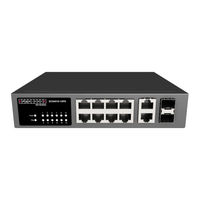Edge-Core ECS4510-12PD Manuals
Manuals and User Guides for Edge-Core ECS4510-12PD. We have 3 Edge-Core ECS4510-12PD manuals available for free PDF download: Web Management Manual, Installation Manual, Quick Start Manual
Edge-Core ECS4510-12PD Web Management Manual (600 pages)
12-Port Gigabit Ethernet Layer 2 Switch
Table of Contents
Advertisement
Edge-Core ECS4510-12PD Installation Manual (52 pages)
12-Port Layer 2 Gigabit Ethernet Switch
Brand: Edge-Core
|
Category: Network Router
|
Size: 2 MB
Table of Contents
Edge-Core ECS4510-12PD Quick Start Manual (6 pages)
L2 Gigabit Ethernet Switch
Advertisement


